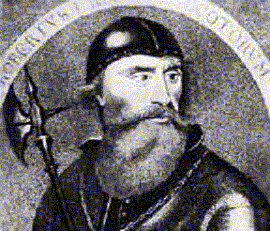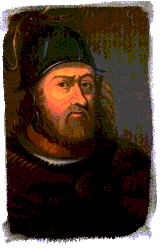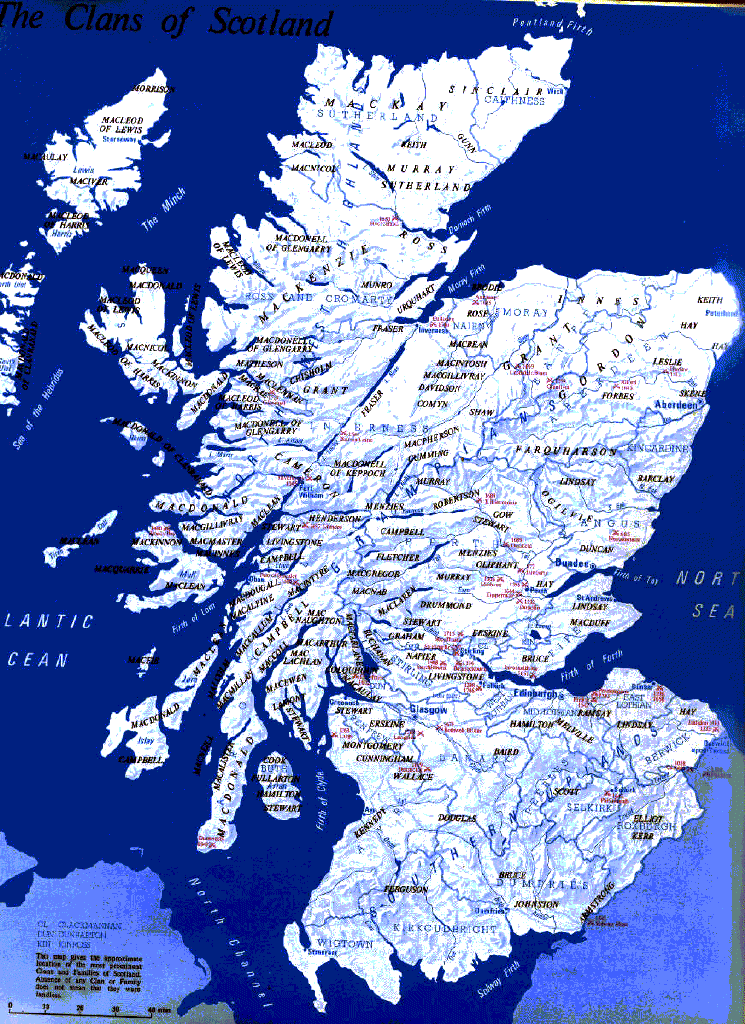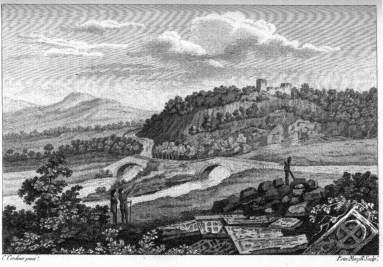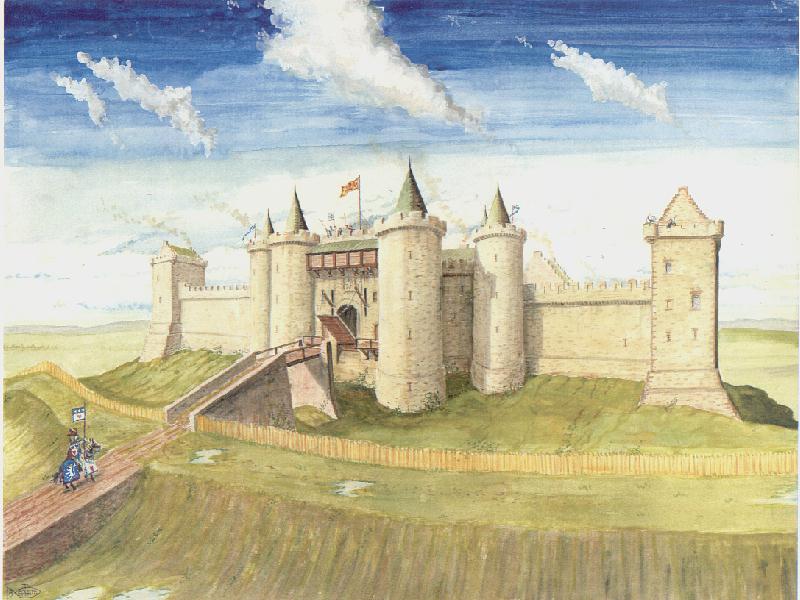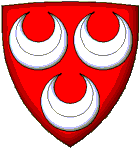Walter's descendant, a Sir Laurence Oliphant of Aberdalgie (son of Sir John Oliphant of Alberdalgie, who had been knighted by Robert II and who was killed at the Battle of Arbroath fighting alongside the Ogilvies *15, the Clan of his wife Margaret (see Battle of Arbroath,) was created the 1st Lord Oliphant. The 1st Lord was one of Scotland's ambassadors to England, and later to France (a prominent position, as Scotland and France (the two countries comprising the famed "Auld Alliance") had often allied against the powerful English.) Laurence later became keeper of Edinburgh Castle *16, and was elected to act on behalf of the Scottish government (along with the Duke or Argyll, Lord Drummond, William Elphinstone, Lord Lyle, Archibald Whitelaw, and Duncan Dundas,) in order to keep the peace between Scotland and England *17. He had three sons, John, who became the 2nd Lord, William, from whom descended the Oliphants of Berriedale, and George who became Oliphant of Bachilton (in Angus). This William married Christian Sutherland, the daughter and heiress of Alexander Sutherland of Duffus (a marriage that was partly responsible for the myth that the Oliphants were a sept of Clan Sutherland, see Clan Relations). Through this marriage, William (who thereafter was styled Oliphant of Berriedale), received approximately a quarter of the entire county of Caithness, including the castles there of Oldwick and Berriedale in Caithness, and the land of Strabrock near Edinburgh.
During this period of the early 16th century, James IV, in loyalty to France, who were at war with England, drove the largest Scottish army ever assembled (estimated at 20,000), and met the Earl of Surrey at Flodden in 1513. The war was disastrous for the Scots, many of whom fell with their proud King, including the then Chief of Clan Oliphant, Colin, Master of Oliphant (son of John, 2nd Lord, and Elizabeth Campbell, daughter of Colin, chief of the Lochlow Campbells), and Laurence Oliphant, his brother, who was the Abbot of Inchaffray.
William Oliphant of Berriedale begat Andrew, who, having no male heir, ceded the land to his chief Laurence, 3rd Lord Oliphant (son of Colin, master of Oliphant, and Elizabeth Keith, daughter of the Earl Marishal), in return for Laurence finding suitable matches to his 3 daughters Margaret, Katherine, and Helen. This Laurence made his seat in Caithness, and the Oliphant Clan came into conflict with the clans of the North, including the Dunns, Sutherlands, and most notably the Sinclairs (the Chief of the Sutherlands, and the Lords Oliphant, later signed a mutual bond of manrent, as they were both troubled by the Sinclairs. This further perpetuated the myth that the Oliphants are a sept of the Sutherlands.) Of this rivalry comes a story that survives in Caithness to this day. While Laurence (who was said to be fond of the chase) was out hunting around the hill of Yarrows in Caithness, he was ambushed by a group of the Sinclair clan, including their chief, the Earl of Caithness. Oliphant was without attendants but had a fast horse, which took him back to Old Wick Castle (also known as Castle Oliphant.) Upon arrival, Lord Oliphant found the drawbridge up. His pursuers were close, and he hadn't even time to sound his horn. At this moment, the bold Lord Oliphant made the decision to jump the moat which separated the castle from the rest of the promontory on which it stood (approximately 25 feet in all) and, in a single leap, his stallion carried his master over the chasm, landing him safely and unharmed to the other side.
In the mid 1500's, George, the Earl of Caithness, held an heritable Justicary of Caithness, Sutherland, and Strathnaver from Portinculter to the Pentland Firth, making him the final legal arbiter of all crimes, including rebellion. He greatly abused this power to his own benefit against his many enemies of the area, including the Oliphants. In 1569, his son John, Master of Caithness, besieged the Lord Oliphant at Old Wick. The clan present held out for 8 days, but were forced to capitulate due to "viveris specielle watter", the lack of food and water. Later in Court the 3rd Lord appealed to the Privy Coucil "that it is not possible for (him) to get justice in a court presided over by the Earl of Caithness", and that he wanted an impartial tribunal, but this request was denied.
After relations between James V of Scotland and Henry VIII of England soured, James raised an army of 15,000 men to advance into England, meeting there the Earl of Wharton. This war was unpopular among the Scottish Lord's, however Laurence, 3rd Lord Oliphant, as the Clan was known to be constant supporters of the Stuart Kings, went to the Battle of Solway Moss, under, ironically, the "King's favourite", Oliver Sinclair of Pitcairns (a branch of the Caithness clan). The army was again routed, due to the infighting and overall unpopularity of the war. Laurence was captured and later ransomed.
Laurence, 4th Lord Oliphant (son of the 3rd Lord), was a supporter of Mary Queen of Scots. He was one of those who acquitted Bothwell for the murder of Darnley, and signed the bond for and attended the Royal Marriage. He fought at the Queen's final defeat at Langside. Laurence, 4th Lord, lived out his days in Caithness, dying there in 1592.
The son of this Laurence, Laurence, Master of Oliphant, was involved in one of the events that brought down the chiefly line of the Oliphants from their position of power in Scotland, the Raid of Ruthven. James the VI of Scotland became king at 13 months of age, after his mother, Mary Queen of Scots, was forced to abdicate. As James was obviously unable to rule a country, he became a pawn in the struggle for power during the height of tension brought on by the reformation. He was raised a Catholic, but was however pressured by the Scottish nobles, many of whom were Protestant. He was closely associated with his cousin, Esme Stewart, successively the Earl (1580) and duke (1581) of Lennox. Although both Stewart, and James VI, declared themselves in favour of the reformation, it seemed to the militant Presbyterians (led by William Ruthven, Earl of Gowrie) that James was being pressured by the Duke (who was raised in Catholic France, and was a supporter of the Catholic Mary Queen of Scots). Their fear was so great of a counter-revolution, that they kidnapped the young King in 1582, while he was out hunting in Atholl. The next day, he signed a document proclaiming that he was free, and that the Duke of Lennox was to be banished from Scotland. James VI was held in the House of Ruthven for almost a year, while the Protestant coup effectively ruled Scotland to their own benefit. James escaped during a visit to St. Andrews. In 1584, the conspirators tried again but this attempt was foiled by the arrest of the Earl of Gowrie who was duly executed. The Masters of Oliphant and Morton (brother in law to the said Master of Oliphant) managed to escape, and were never seen again; their boat was lost at sea, said to have been captured by dutchmen, but later storied abouned that they were enslaved by Turks in the Mediterranean Sea. One Robert Oliphant went to Algiers to try to find them, and there is said to be a plaque in the church there of these two young men.
The Oliphants fell off the map politically after the death of the 4th Lord Oliphant, The son of the above mentioned Master of Oliphant, also named Laurence, was named the 5th Lord Oliphant. Due to the actions of his father, and his confused Catholic/Protestant upbringing (his father being Protestant, and his grandfather Catholic), the 5th Lord dissipated the Oliphant lands in full,including the ancient Oliphant lands of Aberdalgie and Dupplin to the Hays, who subsequently became Viscounts Dupplin and later still the Earls of Kinnoull, both titles still held today. Notably, he sold the extensive Oliphant lands in Caithness to the Earl of Caithness in 1604; Muirhouse was sold in 1605, and Kellie Castle (which by then had been in Oliphant hands for nearly 300 years) in 1613; Newtyle and Auchtertyre in 1617; and Gask was sold in portions in 1610 and 1614 to a cadet line. By 1625, the Gask branch were recognised as the Oliphants of Gask under the Great Seal. The King (Charles I) was present in court when Anna, the 5th Lord's daughter (who was married to a younger son of another noble line) was fighting with her father's cousin Patrick (son of John of Newtyle, who was the son of Laurence, 4th Lord Oliphant) for the title. The King required the title be surrendered to the crown and then created Anna's husband the first Lord Mordington together with the precedence of the Lordship of Oliphant. He then made Patrick (and the heirs- male of his body) the Lords Oliphant (Patrick being the 6th Lord). The title passed thereafter successively to Patrick's son Charles, 7th Lord, to Charles' son Patrick, 8th Lord, to Charles' brother William, 9th Lord, and to a nephew of Charles', Francis, 10th Lord. In 1748, this line died out, thus ending the Lordship of Oliphant and with it, pro tem, the chiefship. |





